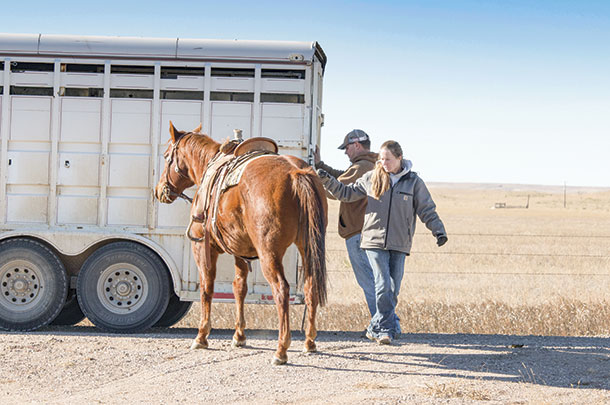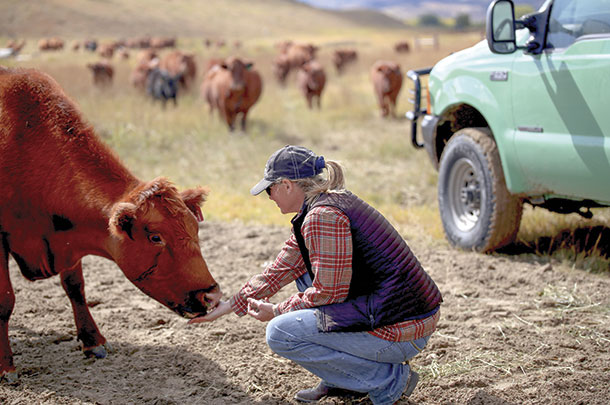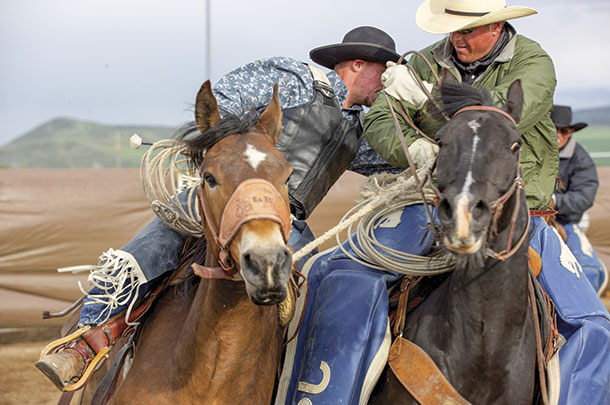Flip open any trade magazine or scroll through online classifieds, and you’ll find a similar advertisement. The problem: Most people can’t afford not to have health insurance, to work 50-plus hours on salary and to raise a family two or more hours from town.
So, what do you do?
Kim Cullen Goertz and her husband, Jason Goertz, raise registered Red Angus (K2 Red Angus) and a commercial herd that is managed for Jason’s family’s all-natural retail meat business. And, like most mid- to large-scale cattle operations, they could always use some extra hands.
Located in Wheatland, Wyoming, about an hour north of Cheyenne, Kim and Jason, along with their two young kids, keep busy with two calving seasons, two production sales, dryland and irrigated crops, an extensive embryo transfer and A.I. program, not to mention all the daily mundane tasks of ranch life.
 “Finding good labor is an issue,” Kim says. “The old-style ranch employee that’s on call 24-7 for terrible wages and lives in a cruddy house because they love to cowboy doesn’t really exist anymore. And that’s not what we want either.”
“Finding good labor is an issue,” Kim says. “The old-style ranch employee that’s on call 24-7 for terrible wages and lives in a cruddy house because they love to cowboy doesn’t really exist anymore. And that’s not what we want either.”
Breaking the mold
Through relationships created in her custom A.I. business years ago and by word-of-mouth, Kim and Jason have rounded up a nontraditional workforce that has worked exceptionally well for the past 10 years.
Currently, there are four employees (Clay, Abby, Brook, Eric) who help on a consistent basis. Some work during certain seasons, some work as-needed, some are paid salary, and some are paid by the hour. But the one similarity is: All of them have another job, or a spouse with a good job and benefits, and don’t want to cut ranching out of their life completely.

Kim explains most staff have a small cow herd of their own. A big draw and benefit to them is a place to run their cattle. She says, “For someone who wants to stay in the cattle business and only has 20 cows or so, it can be really hard to find places to run the cows.
I know when I started, that was my biggest thing. I couldn’t find pasture; all the big ranchers had it and that sort of thing. So we say, ‘OK, run 20 or so cows with us.’”
When asked if they have any restrictions on the number or quality of cattle they bring, Kim says most of that is taken care of with the people they work with. “If we didn’t have the same mentality and ideas about cattle, we wouldn’t work together in the first place,” she says. “Three out of the four came from my old A.I. business, so they are on the same page when it comes to quality.”
Kim says two members of their staff, Eric and Clay, raise black cattle. While she jokes they aren’t allowed to bring a black bull on their place, she will help A.I. their cows, or they are welcome to use one of their Red Angus bulls. Likewise, Brook has a small registered Red Angus herd and will put a bull or two in the production sale. And Abby has a red baldy program where she will sell a few heifers as well.
“Our goal was to give them some incentive, not just a paycheck,” Jason says. “It gives them an invested interest in our program.”
Making it work
Although it can be a bit chaotic at times, Kim says they plan A.I. dates, preg check dates and those types of things around who can be available. Clay works as a rodeo pick-up man, so at certain times in the summer he isn’t available. Brook works for the USDA and, any chance she gets, she is working cows and is almost always available on the weekends.

Abby took over Kim’s old A.I. business, so she is strapped certain times of the year and available the rest. And Eric is chasing the rodeo circuit as a bronc rider, so he is available some weeks at a time and gone the others.
Kim explains having two calving seasons helps alleviate some of the headache in coordinating schedules. They have a spring- and summer-calving herd, allowing them to spread out the need for labor so everyone isn’t needed at once.
“Running them as two separate herds helps cut down on the labor because we only have to worry about one herd at a time,” Kim explains. “That doesn’t mean our summer-calving herd is a dumping place for low-fertile cattle. We don’t put open cattle out of the spring herd into the summer breeding program to give them another chance. We feel like having both calving seasons is the best spread for our labor and resources. Breeding, branding and weaning are all spread out the same way.”
When asked how she would recommend others take the same labor approach, she said: “It takes time. Three out of the four people we have started with my old A.I. business.
I was told to call Clay when I was desperate for more help in A.I. He came. I always knew Brook was a handy person and a hard worker – and was talking to her one day and asked if she would be interested. She came. I think my A.I. business just drew the right kind of people. Horses are another big draw; people want to be able to work their horses.”
While Kim and Jason are fully aware their approach won’t work for everyone, they recognize that like everything in ranch life, a little creativity, baling twine and duct tape can help string together a solution to some of the biggest problems – even when it comes to labor. ![]()
PHOTO 1: K2 Red Angus heifers trailing in early summer. Photo by Kim Cullen Goertz.
PHOTO 2: Jason and Kim Goertz schedule A.I. dates, preg check dates and those types of things around who can be available. Photo by Cassidy Woolsey.
PHOTO 3: Brook, one of the ranch employees, works for the USDA and helps on the ranch any chance she gets. Photo by Kim Cullen Goertz.
PHOTO 4: Clay (right), one of the ranch employees, is a rodeo pick-up man, so he isn’t available during certain times of the summer. Photo provided by Buffy Kelly.

-
Cassidy Woolsey
- Editor
- Progressive Cattleman
- Email Cassidy Woolsey






